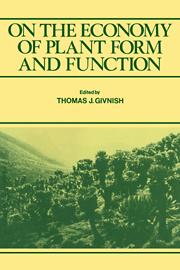Description
On the Economy of Plant Form and Function
Proceedings of the Sixth Maria Moors Cabot Symposium
Coordinator: Givnish Thomas J.
This book summarizes the major recent advances in the economic analysis of plant behavior.
Language: English
Subject for On the Economy of Plant Form and Function:
Publication date: 11-2005
736 p. · 15.7x23.4 cm · Paperback
736 p. · 15.7x23.4 cm · Paperback
Description
/li>Contents
/li>
Recent studies that analyze the impact of various plant traits on whole-plant growth and competitive ability have provided insights into the selective pressures on characteristics such as leaf reflectivity, effective leaf size, stomatal conductance, size of photosynthetic enzyme pools, crown form, xylem structure, nitrogen fixation, and root versus shoot allocation. This research has reached an exciting stage, leading to quantitative predictions of favoured trends in these traits as a function of environmental parameters and fundamental physiological constraints. Such results reveal the importance of ecological patterns in plant form and physiology, and of evolutionary constraints on photosynthesis and primary productivity. On the Economy of Plant Form and Function summarizes the major recent advances in the economic analysis of plant behavior and suggests a framework for a unified, quantitative approach to understanding photosynthetic adaptations, their integration with other aspects of plant form, and their relationship to carbon balance and ultimate limits on plant productivity.
Acknowledgments; Introduction; Part I. Economics of Gas Exchange: 1. The photosynthesis-nitrogen relationship in wild plants Christopher Field and Harold A. Mooney; 2. Modifications of solar-radiation absorption patterns and implications for carbon gain at the leaf level James R. Ehleringer and Kenneth S. Werk; 3. Form and orientation in relation to PAR interception by cacti and agaves Park S. Nobel; 4. Unusual strategies of light absorption in rain-forest herbs David W. Lee; 5. Economics of carbon fixation in higher plants Ian R. Cowan; 6. Optimal stomatal conductance, allocation of energy between leaves and roots, and the marginal cost of transpiration Thomas J. Givnish; 7. Internal leaf structure: a three-dimensional perspective David F. Parkhurst; 8. Competing root systems: morphology and models of absorption Martyn M. Caldwell and James H. Richards; 9. Belowground costs: hydraulic conductance Edwin L. Fiscus; 10. Economy of symbiotic nitrogen fixation John S. Pate; 11. Ecological patterns of xylem anatomy Pieter Baas; 12. Turgor maintenance in Hawaiian Dubautia species: the role of variation in tissue osmotic and elastic properties Robert H. Robichaux, Kent E. Holsinger and Suzanne R. Morse; 13. Adaptations for water and thermal balance in Andean giant rosette plants Frederick Meinzer and Guillermo Goldstein; Part II. Economics of Support: 14. Evolution of plant life forms John A. Raven; 15. Branching patterns and angles in trees Jack B. Fisher; 16. Biomechanical constraints on crown geometry in forest herbs Thomas J. Givnish; 17. The roles of carbon balance and branching pattern in the growth of woody species E.-Detlef Schulze, Manfred Küppers and Rainer Matyssek; 18. Seaweeds in moving water: form and mechanical function Mimi A. R. Koehl; 19. Functional geometry of seaweeds: ecological consequences of thallus layering and shape in contrasting light environments Mark E. Hay; Part III. Economics of Biotic Interactions: 20. Costs of defense and their effects on plant productivity Sherry L. Gulmon and Harold A. Mooney; Index.
© 2024 LAVOISIER S.A.S.




